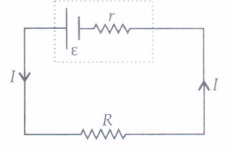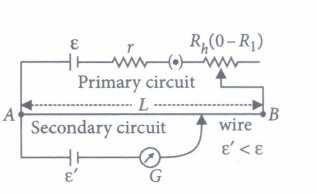In Class 12 Boards there will be Case studies and Passage Based Questions will be asked, So practice these types of questions. Study Rate is always there to help you. Free PDF Download of CBSE Class 12 Physics Chapter 3 Current Electricity Case Study and Passage-Based Questions with Answers were Prepared Based on Latest Exam Pattern. Students can solve NCERT Class 12 Physics Case Study Questions Current Electricity to know their preparation level.
Join our Telegram Channel, there you will get various e-books for CBSE 2024 Boards exams for Class 9th, 10th, 11th, and 12th.
In CBSE Class 12 Physics Paper, Students will have to answer some questions based on Assertion and Reason. There will be a few questions based on case studies and passage-based as well. In that, a paragraph will be given, and then the MCQ questions based on it will be asked.
Current Electricity Case Study Questions With Answers
Here, we have provided case-based/passage-based questions for Class 12 Physics Chapter 3 Current Electricity
Case Study/Passage-Based Questions
Case Study 1: Emf of a cell is the maximum potential difference between two electrodes of the cell when no current is drawn from the cell. Internal resistance is the resistance offered by the electrolyte of a cell when the electric current flows through it. The internal resistance of a cell depends upon the following factors;
(i) distance between the electrodes
(ii) nature and temperature of the electrolyte
(iii) nature of electrodes
(iv) area of electrodes.
For a freshly prepared cell, the value of internal resistance is generally low and goes on increasing as the cell is put to more and more use. The potential difference between the two electrodes of a cell in a closed circuit is called terminal potential difference and its value is always less than the emf of the cell in a closed circuit. It can be written as V = E – Jr.
(i) The terminal potential difference of two electrodes of a cell is equal to emf of the cell when
| (a) I≠0 | (b) I=0 | (c) both (a) and (b) | (d) neither (a)nor (b) |
Answer: (b) I=0
(ii) A cell of emf E and internal resistance r gives a current of 0.5 A with an external resistance of 12Ω and a current of 0.25 A with an external resistance of 25Ω . What is the value of the internal resistance of the cell?
| (a) 5Ω | (b) 1Ω | (c) 7Ω | (d) 3Ω |
Answer: (b) 1Ω
(iii) Choose the wrong statement.
| (a) Potential difference across the terminals of a cell in a closed circuit is always less than its emf. |
| (b) Internal resistance of a cell decrease with the decrease in temperature of the electrolyte. |
| (c) Potential difference versus current graph for a cell is a straight line with a -ve slope |
| (d) Terminal potential difference of the cell when it is being charged is given as V = E + Ir. |
Answer: (b) Internal resistance of a cell decrease with the decrease in temperature of the electrolyte.
(iv) An external resistance R is connected to a cell of internal resistance r, the maximum current flows in the external resistance, when
| (a) R = r | (b) R < r | (c) R> r | (d) R=l/r |
Answer: (a) R = r
(v) IF external resistance connected to a cell has been increased to 5 times, the potential difference across the terminals of the cell increases from 10 V to 30 V. Then, the emf of the cell is
| (a) 30 V | (b) 60V | (c) 50 V | (d) 40 V |
Answer: (b) 60V
Case Study 2: The potentiometer is an apparatus used for measuring the emf of a cell or potential difference between two points in an electrical circuit accurately. It is also used to determine the internal resistance of a primary cell. The potentiometer is based on the principle that, if V is the potential difference across any portion of the wire of length 1 and resistance R, then V∝l or V=klV∝l or V=kl where k is the potential gradient. Thus, the potential difference across any portion of the potentiometer wire is directly proportional to the length of the wire of that portion. The potentiometer wire must be uniform. The resistance of the potentiometer wire should be high.
(i) Which one of the following is true about the potentiometer?
| (a) Its sensitivity is low |
| (b) It measures the emf of a cell very accurately |
| (c) It is based on the deflection method |
| (d) None of the above |
Answer: (b) It measures the emf of a cell very accurately
(iii) Sensitivity of a potentiometer can be increased by
| (a) decreasing potential gradient along the wire | (b) increasing potential gradient along the wire |
| (c) decreasing current through the wire | (d) increasing current through the wire |
Answer: (a) decreasing potential gradient along the wire.
(iv) A potentiometer is an accurate and versatile device to make electrical measurements of EMF because the method involves
| (a) potential gradients |
| (b) a condition of no current flow through the galvanometer |
| (c) a combination of cells, galvanometer and resistances |
| (d) cells |
Answer: (b) a condition of no current flow through the galvanometer
(v) In a potentiometer experiment, the balancing length is 8 m, when the two cells El and E2 are joined in series. When the two cells are connected in opposition the balancing length is 4 m. The ratio of the e. m. f. of two cells (El/E2) is
| (a) 1: 2 | (b) 2: 1 | (c) 1: 3 | (d) 3: 1 |
Answer: (d) 3: 1
Case Study 3: Current Electricity, delves into the concepts surrounding the flow of electric charge. It begins with the definition of electric current as the rate of flow of electric charge through a conductor. Ohm’s law, a fundamental principle in this chapter, states that the current through a conductor between two points is directly proportional to the voltage across the two points and inversely proportional to the resistance between them. The chapter also covers the concept of resistivity, which is a material-specific property indicating how strongly that material opposes the flow of electric charge. The influence of temperature on resistance is also explained, and the chapter ends with the analysis of series and parallel circuits, highlighting Kirchhoff’s laws.
What is electric current?
A) The amount of electric charge flowing through a conductor.
B) The rate of flow of electric charge through a conductor.
C) The voltage across two points in a conductor.
D) The resistance between two points in a conductor.
What does Ohm’s law state?
A) The current through a conductor is directly proportional to the voltage and the resistance.
B) The current through a conductor is directly proportional to the voltage and inversely proportional to the resistance.
C) The current through a conductor is inversely proportional to the voltage and directly proportional to the resistance.
D) The current through a conductor is independent of the voltage and the resistance.
What is resistivity?
A) A property indicating how strongly a material conducts electric charge.
B) A property indicating how strongly a material opposes the flow of electric charge.
C) The resistance of a unit length of a material.
D) The current flowing through a unit length of a material.
What is the effect of temperature on resistance?
A) Temperature has no effect on resistance.
B) As temperature increases, resistance decreases.
C) As temperature increases, resistance increases.
D) As temperature decreases, resistance increases.
What are Kirchhoff’s laws used for?
A) Analyzing fluid dynamics in a system.
B) Analyzing heat transfer in a system.
C) Analyzing gravitational forces in a system.
D) Analyzing electric circuits.
Answers:
- B) The rate of flow of electric charge through a conductor.
- B) The current through a conductor is directly proportional to the voltage and inversely proportional to the resistance.
- B) A property indicating how strongly a material opposes the flow of electric charge.
- C) As temperature increases, resistance increases.
- D) Analyzing electric circuits.
Hope the information shed above regarding Case Study and Passage Based Questions for Class 12 Physics Chapter 3 Current Electricity with Answers Pdf free download has been useful to an extent. If you have any other queries about CBSE Class 12 Physics Current Electricity Case Study and Passage-Based Questions with Answers, feel free to comment below so that we can revert back to us at the earliest possible.
By Team Study Rate



